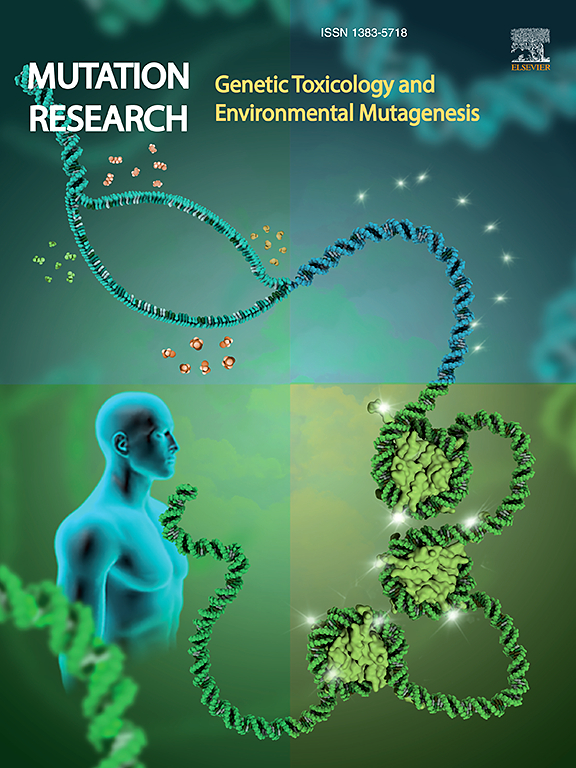化学遗传毒性评价中γ - h2ax /pH3生物标志物定量方法的比较
IF 2.5
4区 医学
Q3 BIOTECHNOLOGY & APPLIED MICROBIOLOGY
Mutation research. Genetic toxicology and environmental mutagenesis
Pub Date : 2025-07-25
DOI:10.1016/j.mrgentox.2025.503878
引用次数: 0
摘要
化学品风险评估依赖于体外遗传毒性试验。组蛋白修饰(γ - h2ax和pH3)已成为遗传毒性检测的有价值的生物标志物。在这项研究中,我们比较了γ - h2ax生物标志物的三个参数(全局强度、核强度和焦点数)和pH3生物标志物的两个参数(全局强度和有丝分裂中细胞百分比)。这些分析是在三种细胞系中进行的:人骨肉瘤U2OS细胞、人肝癌HepG2细胞和大鼠肠上皮IEC-6细胞。将细胞暴露于四种具有明确特征的有害物质中24 h:诺可达唑(aneugen)、依托泊苷(拓扑异构酶抑制剂)、苯并[a]芘(DNA加合物诱导剂)和tunicamycin(凋亡诱导剂)。基准浓度(BMC)方法表明,该技术的灵敏度取决于化学成分和被测细胞系。γ - h2ax聚焦分析对致裂化合物具有较高的灵敏度。对于非优生化合物,整体强度和有丝分裂细胞的比例表现出相似的敏感性。tunicamycin处理后,我们在U2OS细胞模型中仅检测到γ - h2ax核强度的增加,表明凋亡不干扰γ - h2ax的整体强度或灶数,从而最大限度地降低了假阳性结果的风险。最后,我们观察到,与其他方法相比,全局强度允许监测较弱的生物标志物诱导。通过比较不同的组蛋白修饰作为遗传毒性生物标志物的定量方法,本研究突出了最适合使用的参数。本文章由计算机程序翻译,如有差异,请以英文原文为准。
Comparison of different techniques for γH2AX/pH3 biomarkers quantification for chemical genotoxicity assessment
Chemical risk assessment relies on in vitro genotoxicity tests. Histone modifications (γH2AX and pH3) have emerged as valuable biomarkers for genotoxicity detection. In this study, we compared three parameters (global intensity, nuclear intensity, and foci number) for the γH2AX biomarker and two parameters (global intensity and % cell in mitosis) for the pH3 biomarker. These analyzes were performed in three cell lines: human osteosarcoma U2OS cells, human hepatocellular carcinoma HepG2 cells and rat intestinal epithelial IEC-6 cells. Cells were exposed for 24 h to four well-characterized hazardous substances: nocodazole (aneugen), etoposide (topoisomerase inhibitor), benzo[a]pyrene (DNA adducts inducer), and tunicamycin (apoptosis inducer). The Benchmark Concentration (BMC) approach indicated that the sensitivity of the technics varied depending on both the chemical compounds and the tested cell line. The γH2AX foci analysis provided the higher sensitivity for clastogenic compounds. For the aneugenic compound, the global intensity and the proportion of mitotic cells showed similar sensitivity. Following tunicamycin treatment, we only detected increase in γH2AX nuclear intensity in U2OS cell model, indicating that apoptosis does not interfere with γH2AX global intensity or foci number, thereby minimizing the risk of false positive results. Finally, we observed that compared to the other methods, global intensity permitted to monitor weaker fold inductions of the biomarkers. By comparing the different quantification methods of histone modifications used as genotoxicity biomarkers, this study highlights the most suitable parameters to be used.
求助全文
通过发布文献求助,成功后即可免费获取论文全文。
去求助
来源期刊
CiteScore
3.80
自引率
5.30%
发文量
84
审稿时长
105 days
期刊介绍:
Mutation Research - Genetic Toxicology and Environmental Mutagenesis (MRGTEM) publishes papers advancing knowledge in the field of genetic toxicology. Papers are welcomed in the following areas:
New developments in genotoxicity testing of chemical agents (e.g. improvements in methodology of assay systems and interpretation of results).
Alternatives to and refinement of the use of animals in genotoxicity testing.
Nano-genotoxicology, the study of genotoxicity hazards and risks related to novel man-made nanomaterials.
Studies of epigenetic changes in relation to genotoxic effects.
The use of structure-activity relationships in predicting genotoxic effects.
The isolation and chemical characterization of novel environmental mutagens.
The measurement of genotoxic effects in human populations, when accompanied by quantitative measurements of environmental or occupational exposures.
The application of novel technologies for assessing the hazard and risks associated with genotoxic substances (e.g. OMICS or other high-throughput approaches to genotoxicity testing).
MRGTEM is now accepting submissions for a new section of the journal: Current Topics in Genotoxicity Testing, that will be dedicated to the discussion of current issues relating to design, interpretation and strategic use of genotoxicity tests. This section is envisaged to include discussions relating to the development of new international testing guidelines, but also to wider topics in the field. The evaluation of contrasting or opposing viewpoints is welcomed as long as the presentation is in accordance with the journal''s aims, scope, and policies.

 求助内容:
求助内容: 应助结果提醒方式:
应助结果提醒方式:


